35+ Top Blogging Statistics For 2024: The Definitive List
“Blogging is dead” they said.
Yet here we are, more than a decade later, and blogging is still a powerful inbound marketing medium and source of revenue for many.
To shed some light on the current state of blogging, we’ve compiled a list of the most important blogging statistics, trends, and facts.
These blogging stats will show you exactly what blogging looks like this year and provide useful insights you can use to inform your blogging strategy.
Editor’s picks
- There are at least half a billion blogs on the internet. (Statista)
- 86% of content marketers use blog posts as part of their strategy. (Semrush)
- Only 1 in 3 bloggers monetize their blogs. (Hosting Tribunal)
Key blogging statistics
Let’s start by taking a look at some of the most important blogging statistics.
There are at least half a billion blogs on the internet
500 million is a conservative ballpark estimate, given that there were 496 million blogs on Tumblr alone as of April last year. And that’s not even counting those running on other blogging platforms such as Wix, WordPress, and Blogger.
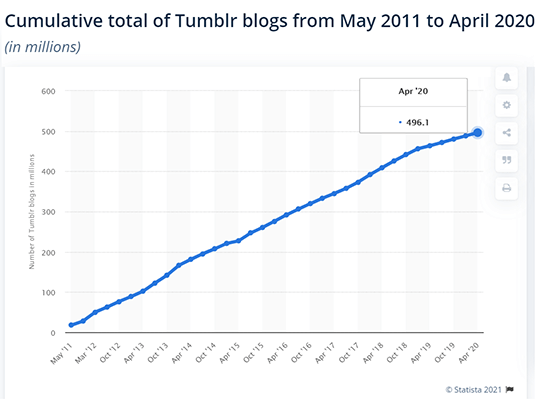
The takeaway: Yes, the blogging space is definitely saturated at this point, but there’s always room for more. It’s still possible to carve out your own space in the market if you find the right niche and consistently create high-quality content.
77% of all internet users still read blogs
“Who even reads blogs anymore, am I right?” Nope. As it turns out, you’re very wrong.
77% of all internet users regularly read blogs – and some of them probably don’t even know it. A huge chunk of the informational content we consume while looking for information are blog posts, even if they don’t look like it. How-to posts, listicles, and buying guides are just some of the many different formats that blog posts can take.
(Source: djohncarlsonesq.com)
The top blogs make over $1m+ per year
If you were wondering if you can still make money blogging, here’s your answer. The top 0.6% of blogs generate 7 figures a year in revenue.
Don’t worry, I know what you’re thinking: what about the other 99.4%? Well, it’s not just the elite that makes money. The top 10% of bloggers also make over $10,000 per year. That might not be quite a full-time income, but it sure is a nice side-hustle. (Source: Hosting Tribunal)
86% of content marketers use blog posts as part of their strategy
This makes blog posts the most popular content format amongst marketers. Perhaps surprisingly, email comes in at a distant second place at just 67%. (Source: SEMrush)
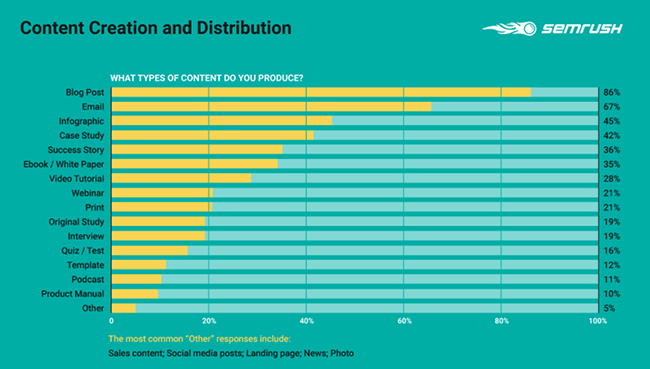
Blogs are the #2 form of media used in content strategy
Blogs lost out on the top spot this year to video, but they’re still a very popular form of media amongst content marketers – and it’s no surprise why. Blog content is a powerful, cost-effective way to generate traffic and leads. (Source: HubSpot, 2020)
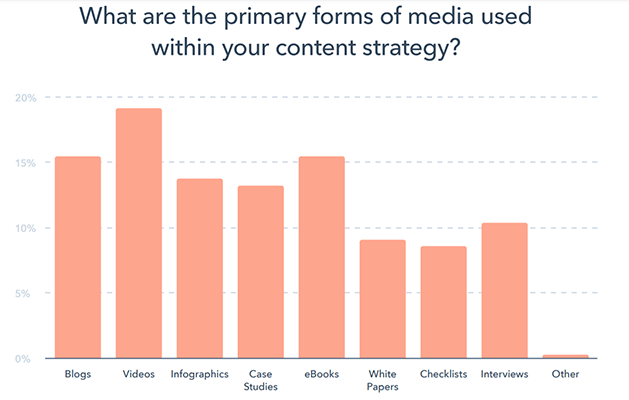
Blogging marketing statistics
Wondering how blogging fits into your marketing strategy? Take a look at the marketing-related blogging stats below.
6. Businesses that blog generate twice the email traffic…
According to a HubSpot study of over 6,000 companies, those that blog get x2 the email traffic compared to those that don’t. Why? Simple: because blog emails contain content that customers want to read, and traditional emails don’t. (Source: HubSpot)
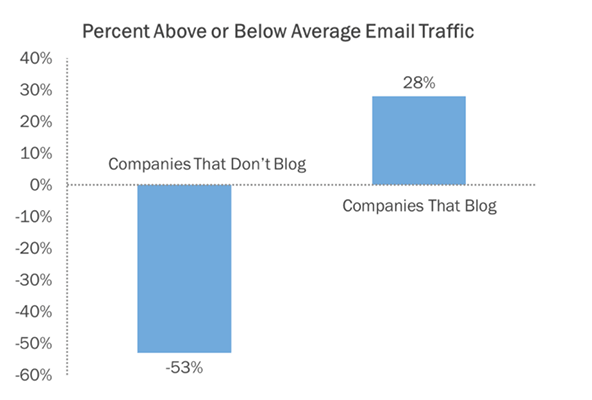
… And 67% more monthly leads
Yup, companies with blogs produce 67% more leads each month than those without them. I think that statistic speaks for itself and proves if more proof be needed just how effective blogging is for lead generation. (Source: Demand Metric)
97% of bloggers promote their blog posts on social media
Distribution is an important part of blog content success – and social media is the go-to distribution channel for bloggers. (Source: Statista)
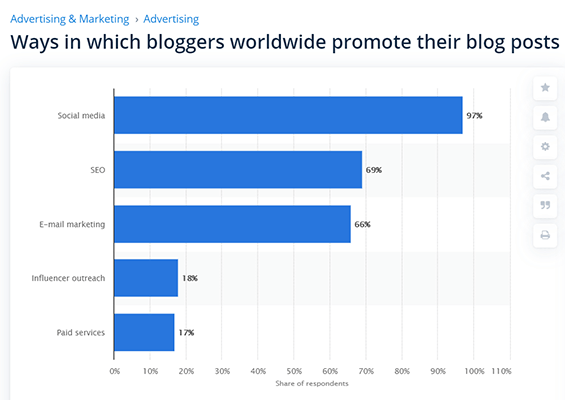
61% of US consumers spend 3x as long consuming blog content than email content
Consumers still spend a lot more time reading blog content than they do emails – but that doesn’t mean you should neglect email marketing either. There’s room for both in your strategy. (Source: Social Media Today)

Businesses with blogs get 97% more inbound links
And as we know, more inbound links means more ranking power. That’s why so many marketers create blog posts as part of their outreach strategy. (Source: HubSpot)
1-2% is the average blog visit-to-lead conversion rate
In a survey by Databox, almost 25% of marketers said they had a lead-to-visit conversion rate somewhere between 1-2%. This is a good benchmark to compare your own blog conversion rates against.
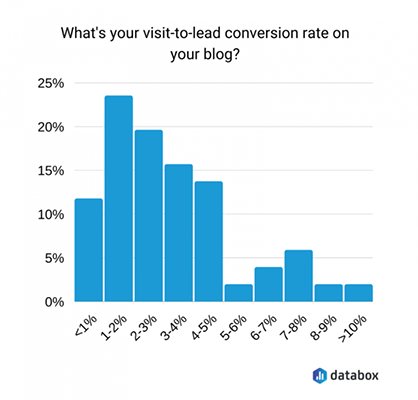
General blogging statistics
Here are some general blogging statistics that shed light on important questions about blogging monetization, growth, frequency, and more.
Only 1 in 3 bloggers monetize their blogs
That means the vast majority (2/3rds) of all blogs out there don’t generate any revenue. These not-for-profit blogs are likely mostly personal blogs run by hobbyists, rather than business blogs. (Source: Hosting Tribunal)
Affiliate marketing is the top blog monetization strategy
Amongst bloggers that do monetize, affiliate marketing is the most popular way of making money. The Amazon affiliate program is particularly popular and allows bloggers to earn affiliate revenue when readers click through their links before purchasing items on Amazon. (Source: First Site Guide)
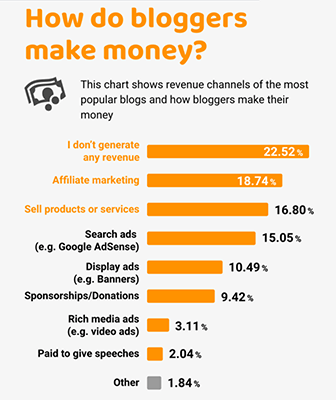
WordPress is the fastest growing blogging platform
Tumblr technically is the most popular blogging platform, given that there are over 470 million blog accounts registered on their platform, but as Tumblr is technically a microblogging platform and more akin to a social media platform than a website builder, it’s better suited to hobbyists than serious bloggers. Amongst business blogs, WordPress remains the gold-standard. (Source: W3techs)
There are roughly 70 million new WordPress blog posts published each month
…and 77 million new comments. And that’s just on WordPress. The total number of blogs across platforms is anyone’s guess, but Worldometers provides a running live estimate based on a formula that factors in WordPress market share and historical trends. As of the time of writing, there have already been 6.4 million blog posts published today.

Content quality is the most important blog success-factor
Making sure you’re writing top-notch content is the number one most important thing you can do to make sure your blog is a success. (Source: GrowthBadger)
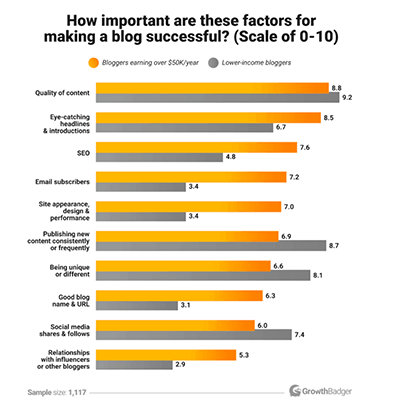
22% of bloggers post 2-3 times per week
If you’re wondering how often you should be publishing new blog posts, 2-3 times a week might be a good place to start. More bloggers post 2-3 times per week than any other frequency. (Source: First Site Guide)
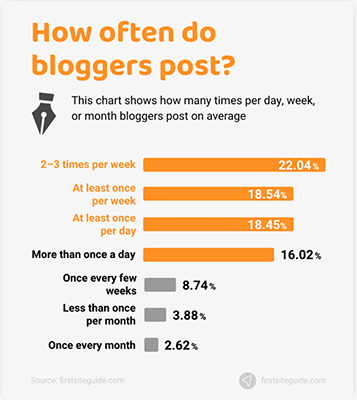
Blogging ranking & SEO statistics
For many bloggers, the goal of each post is to rank at the top of the search results pages for their target keywords. But to do that, you need to nail your on-page SEO. Here are some blogging ranking/SEO stats that’ll help you to do that.
95% of all blog traffic goes to page-1 results
If your post isn’t landing on page 1 for your target keyword, it might as well not exist as far as organic search traffic is concerned. The vast majority of searchers won’t go past the first page to find the content they’re looking for. (Source: Brafton)
The ideal blog post length (for SEO) is 2,100 – 2,400 words
According to data gathered by HubSpot. In other words, blog posts that are in this word count range stand the best chance of ranking well on the SERPs. Earlier data from Backlinko found that the average length of a page-1 blog post was 1890 words.
83% of bloggers still do keyword research
If you thought keywords were no longer relevant, think again. While optimizing your blog posts around a specific keyword might be less important as Google’s algorithm has got better at assessing search intent, it’s still important. And that’s why the vast majority of bloggers still do keyword research to come up with topic ideas for their posts. (Source: Orbitmedia.com)
Most experts think marketers should target 2-5 keywords in each blog post
Don’t just optimize your posts around one keyword. Think about variations of your keyword that your readers are likely to search for and include a handful of them throughout your content. The more keywords you rank for, the more opportunities for traffic your post will get. (Source: Databox)
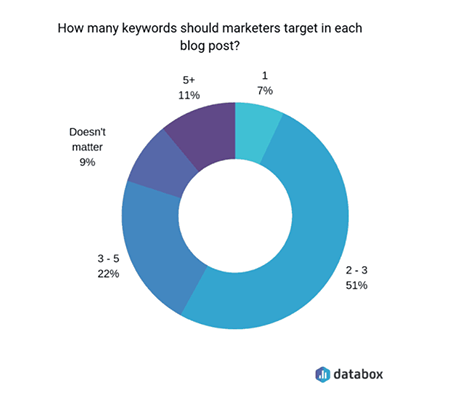
Most blogs ranking on page-1 of Google include the target keyword in their title tag
The title tag has long been considered one of the most important on-page SEO elements, and that still holds true today, as proven by this stat from Backlinko.
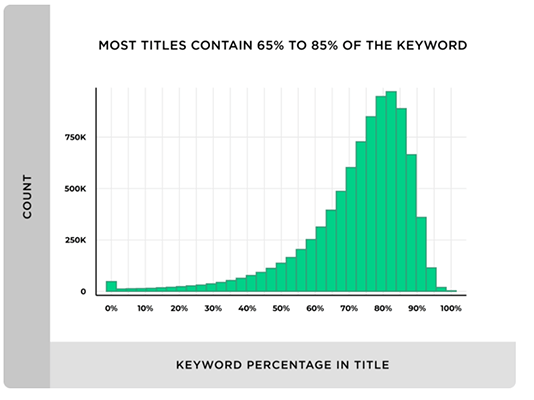
If you want to learn more, be sure to check out our dedicated article on SEO statistics.
Blog content statistics
The blog content statistics below provide useful insight that’ll help you to create high-quality posts that get more clicks, shares, and engagement.
The average blog post length is 1269 words
2,100+ words might be best for SEO purposes, but the majority of blog posts out there are still shorter than that. The average length was 1269 words as of 2020, which is still more than 50% higher than it was 6 years ago.
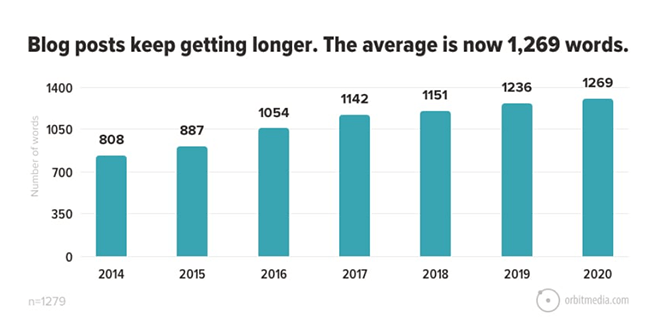
Why the increase? Well, one clear trend over the last few years has been a shift towards long-form content. Google seems to like content that covers a given topic in-depth over thin content. (Source: Orbit Media)
It takes 2-3 hours, on average, to write a blog post
This is how long most respondents in a survey by Databox said they spent creating blog posts. The same respondents said it takes over 8 hours to produce video content. This makes blogging significantly less time consuming than other inbound marketing content creation.
Blog posts that include an image every 75-100 words generate twice the shares
Nobody likes boring walls of text. Visual elements like images and videos enrich your blog posts, help to keep your audience’s attention and make your content much more shareable. Make sure you’re using them in your posts. (Source: HubSpot)
Blog post headlines that are 6-13 words long drive the most traffic
Aim to keep the word count of your headlines somewhere in this range to maximize your traffic potential. (Source: OptinMonster)
Consumers spend 88% more time on pages that include video content
Dwell time is one of the most important metrics you can use to measure the success of a blog. The longer your readers hang around on your post, the greater chance you have of ranking in the search engine results pages for your target keywords.
And one way you can boost your blog post dwell time is to add in video or audio content. 88% of consumers will spend more time on your page if it includes video content, and 45% of bloggers who include audio in their posts achieve better results.
“How-to” posts are the most popular blog content format
77% of respondents in an Orbit Media survey said they’d published how-to articles in the last 12 months. This makes it by far the most popular type of content amongst bloggers. (Source: Orbit Media)
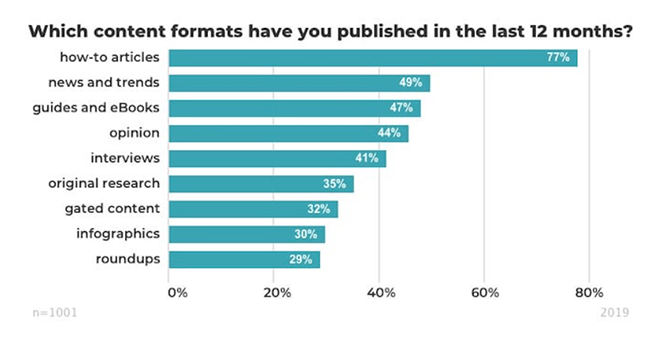
Blogging traffic statistics
Wondering how to drive more traffic to your blog? Check out these blogging traffic statistics.
Businesses that publish 16+ posts/month generate 3.5x more traffic
The upshot of this is clear: more posts means more traffic. Aim to publish at least 3 posts per week if your content calendar allows and watch as your traffic goes through the roof. (Source: HubSpot)
Compounding blog posts generate 38% of all blog traffic
This is despite the fact that only 10% of all blog posts are compounding blog posts. What are compounding posts, you ask?
Well, in a nutshell, they’re posts that generate traffic that grows over time. They’re the opposite of ‘decaying posts’, which are posts that generate traffic that peaks when first published but then declines over time (like news stories and posts about passing trends).
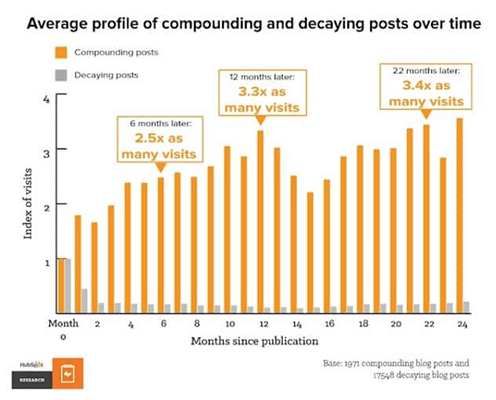
Aim to create content around ‘evergreen topics’ that are likely to appeal to your audience and for years to come and you should see more traffic over the long term. (Source: HubSpot)
The use of promotional techniques to drive blog traffic is up 93% over the past year
It’s getting harder and harder to generate organic traffic, and bloggers/marketers are increasingly reliant on paid ads to drive traffic to their content. (Source: OptinMonster)
Blogging challenges statistics
While blogging might not be dead yet, the industry is nonetheless facing challenges. Here are some statistics that show the main hurdles brands, marketers, and independent bloggers face in getting their posts off the ground this year.
The average reader spends just 37 seconds reading a blog post
What does this mean? It means you need to work harder at grabbing your reader’s attention right off the bat. The average blog reader has a short attention span. Make sure you’re hooking them in in your introduction and keep them engaged with great content so that they stick around. (Source: NewsCred)
Around 27% of US internet users use ad blocking software
That number’s been growing steadily year on year. What does it mean for bloggers? Well, if you generate an income from traditional ad networks, you might want to start looking for new revenue streams. More future-proof monetization strategies include affiliate revenue and sponsored content. (Source: Statista)
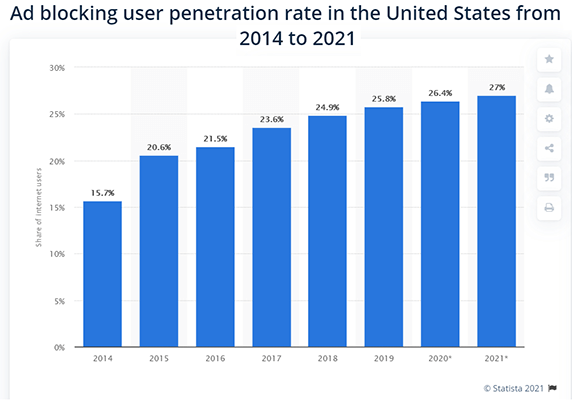
92.42% of keywords get less than ten monthly searches
Finding low-competition, high search-volume keywords is getting harder and harder as the blogging space becomes increasingly saturated. (Source: Ahrefs)
The average top-ranking blog post is 2+ years old
Blogging (and content marketing more generally) has always been a long-term game. It takes a while for your posts to gain traction and start ranking, as this stat proves. The average blog post ranking in the top 10 results is 2+ years old. If you’re looking for fast results and want to drive website traffic quickly, blogging might not be the right way to go. (Source: Ahrefs)
Around 74% of marketers think videos are better than blog posts for lead generation
One trend we’ve seen over the last few years is a ‘pivot to video’. Marketers are increasingly prioritizing video content to generate leads over blog posts – but that doesn’t mean blogs don’t have a place in your strategy.
While video content is great, it typically costs more and takes longer to make than blog content. Plus, it’s not ideal longer in every situation. Some readers (think busy commuters or people in the workplace) are more likely to want to skim a blog post than watch a video.
Final thoughts
There you have it – 36 enlightening blogging statistics, facts, and trends. We hope you were able to draw some useful insights from them!
If you take away just one thing from this article, let it be this: blogging is still a viable marketing method and way to make money as long as you put in the effort.
Focus on creating high-quality content that your readers will love and the traffic will take care of itself.
Looking for more statistics? Check out these hand-picked articles:
